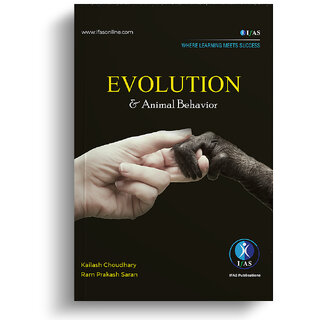
CSIR NET Evolution Animal Behavior Advanced Textbook
Quick Overview
Rs. on ShopcluesBuy
Product Price Comparison
Evolution is the most important field of study to understanding any aspects of lifescience. As truly said by the Theodosius Dobzhansky "Nothing in biology makes sense except in the light of evolution". Biological evolution is the gradual change in inherited traits over successive generations in populations of organisms. The purpose of evolution in most of cases seems to have relatively better adapted population which has more chances of survival in specific ecological habitats, but nothing is universal. Sometime random chance, migration or mutation can lead to evolution. Biological evolution is traditionally studied on basis of paleontological records which show astonishing changes in the composition of major taxonomic groups of animals and plants deposited in sedimentary rocks of various age. Such evidences suggest that aquatic life forms give rise to the first terrestrial plants and animals, amphibians lead to reptiles including dinosaurs, ferns lead to gymnosperms, and then to flowering plants. Extinction of most dinosaurs is followed by the spread of mammals and flying descendants of dinosaurs called birds. These evidences suggest that nothing is permanent - change is law of nature. Even mighty Dinosaurs and tall gymnosperms can fall, time is decider. biogeography, embryology, anatomy, biochemistry, molecular biology and all most all field of biology gives clear indications of biological evolution. Present evolutionary research mainly revolve around natural selection and genetic drift augmented with statistical genetics demonstrated that heritable changes may accumulate in populations and result in replacement of gene variants. We have come to notion that gene mutate, individuals are selected and population evolve. Another fascinating field of study is animal behaviour. Nothing can be more beautiful than watching behaviour of animals in nature. Humans have studied animal behavior since prehistoric times. Understanding the habits of potential prey, as well as those of their predators, was of great value to hunters. Appreciation of behavioral traits led to the domestication of animal species. Accounts of dramatic animal behaviors such as seasonal appearances and disappearances, mating displays, aggression, prey capture, and even less dramatic behaviors such as parental care, communication, and sleep are found throughout recorded history. Animals display various elaborate innate behaviors they do not learn. Web spinning by spiders, for example, requires no practice or prior experience. There are various learned behaviour as well but most animal behavior stems from an interaction of genetic inheritance and learning, and modern studies of animal behavior focus on the mechanisms of both. The evolution of behavior is also a topic of great interest and research on that topic asks how particular behaviors are adaptive in specific environments.
